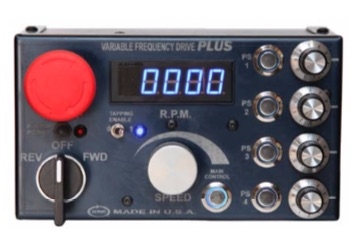
Variable speed components on milling machines typically wear out within 5-10 years and will need to be rebuilt–which could represent thousands of dollars for a stop-gap repair. Unique to the market, there is now a one-time, alternative solution that completely eliminates a machine’s needless sliding variable speed pulley components–providing an ultra-reliable, long-term fix.
SERVO® Products Company (Eastlake, Ohio), a progressive manual knee-type milling machine accessories since 1964, recently introduced designer and manufacturer of a broad line of their new Variable Frequency Drive (VFD) and VFD Plus kits which are full-featured packages designed to convert older step pulley mills and variable speed mills from mechanically controlled speed, into an electronically controlled machine.
The complete VFD kits are “plug-and-play” solutions that are easy to install and easy to operate–quickly upgrading a mills reliability, versatility, and productivity with smoother variable electronic speed control.
Made in the USA, both VFD kits are also suited for smaller garage/machine shops, mills, lathes, and grinders. Adaptable to most applications, the VFD kits can run the motor on 220V single-phase incoming power vs. requiring three-phase power – eliminating the need for a phase converter convenient package, it can go up to 5,000 RPMs in high gear–10-15% higher than the standard milling machine could do. Unlike early VFD kits, these provide full-torque at the lowest RPM.
Notably, both VFD kits feature a red E-Stop button that milling machines typically do not have. There is also an E-Stop safety circuit to prevent accidental start-ups.
SERVO VFD STANDARD SPECS/FEATURES
- Two RPM Ranges
- Full torque throughout the entire RPM range
- Accurate in both gear ranges
- Can run a three-phase motor with single-phase input (up to 3 horsepower)
- Sensorless vector control
- Includes all mounting hardware
- Spindle rotation is always correct
- Bright Blue LED Display that is truly accurate in both gear ranges
- 10 Turn potentiometer for accurate speed control
- Integrated dynamic braking resistor for quick forward/reverse changes (like tapping applications)
- There is a window to view the FVD status
SERVO VFD PLUS SPECS / FEATURES:
SERVO’s VFD Plus has all of the standard VFD features, plus it increases the versatility of mills with essential upgrades including:
4 PRESET SPINDLE SPEEDS: In addition to one main speed for fast speed selection, there are an additional four presets for a total of five! These preset speed controls allow operators to set up to 4 different speeds, and quickly change spindle speeds at the press of a button. The preset speed button lights up and displays RPM’s.
SEMI-AUTOMATED TAPPING FEATURE: The tapping function uses a proximity switch to reverse the spindle at the user set depth to automatically reverse the spindle, and back out of the tap. Once the spindle goes back to the top position, the spindle then turns forward, ready for the next tapping cycle.
You simply put the drill in, and then set the speeds; i.e.-push button “1” at drilling speed, then set push button “2” at a tapping speed. This allows you to run through a desired sequence at the right RPMs.
SERVO VFD & VFD PLUS CONCLUSION
With an eye on innovation, Servo Engineer Garry Yaworski designed the advanced VFD & VFD Plus kits to address the issue of upgrading old-school step pulley type mills and variable speed mills with component failure with a comprehensive solution.
According to Yaworski, “The goal was to improve the mills reliability and productivity with a long-term, all-inclusive fix versus a standard rebuild-type approach. Our VFD kits are comparably priced to a typical variable sped disc to replacement, and allow end-users to take advantage of the versatility and reliability of electronic speed control.”
Contact Details
Related Glossary Terms
- gang cutting ( milling)
gang cutting ( milling)
Machining with several cutters mounted on a single arbor, generally for simultaneous cutting.
- milling
milling
Machining operation in which metal or other material is removed by applying power to a rotating cutter. In vertical milling, the cutting tool is mounted vertically on the spindle. In horizontal milling, the cutting tool is mounted horizontally, either directly on the spindle or on an arbor. Horizontal milling is further broken down into conventional milling, where the cutter rotates opposite the direction of feed, or “up” into the workpiece; and climb milling, where the cutter rotates in the direction of feed, or “down” into the workpiece. Milling operations include plane or surface milling, endmilling, facemilling, angle milling, form milling and profiling.
- milling machine ( mill)
milling machine ( mill)
Runs endmills and arbor-mounted milling cutters. Features include a head with a spindle that drives the cutters; a column, knee and table that provide motion in the three Cartesian axes; and a base that supports the components and houses the cutting-fluid pump and reservoir. The work is mounted on the table and fed into the rotating cutter or endmill to accomplish the milling steps; vertical milling machines also feed endmills into the work by means of a spindle-mounted quill. Models range from small manual machines to big bed-type and duplex mills. All take one of three basic forms: vertical, horizontal or convertible horizontal/vertical. Vertical machines may be knee-type (the table is mounted on a knee that can be elevated) or bed-type (the table is securely supported and only moves horizontally). In general, horizontal machines are bigger and more powerful, while vertical machines are lighter but more versatile and easier to set up and operate.
- tap
tap
Cylindrical tool that cuts internal threads and has flutes to remove chips and carry tapping fluid to the point of cut. Normally used on a drill press or tapping machine but also may be operated manually. See tapping.
- tapping
tapping
Machining operation in which a tap, with teeth on its periphery, cuts internal threads in a predrilled hole having a smaller diameter than the tap diameter. Threads are formed by a combined rotary and axial-relative motion between tap and workpiece. See tap.






